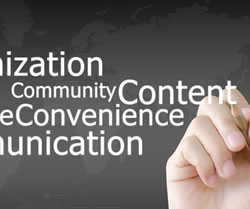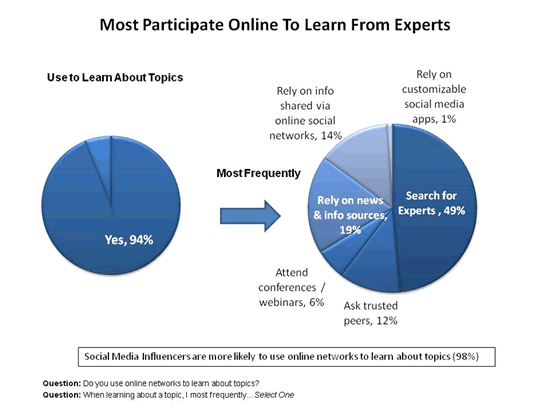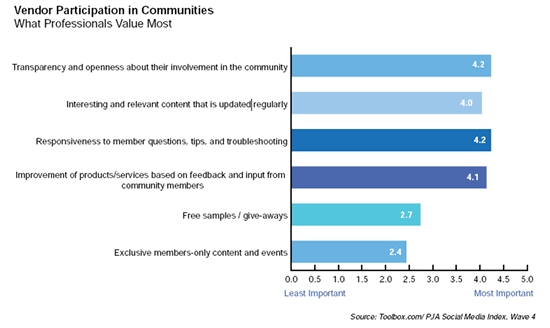Content marketing can serve community building purposes but is rarely enough. An overview and some lessons.
 There is a strong connection between content marketing, social media marketing and online communities, especially the last few years. Although content marketing is connected with all forms of marketing, many tactics used in both overlap as they are umbrella terms and content marketing today is looked upon mainly from an online viewpoint, even if it’s more than that.
There is a strong connection between content marketing, social media marketing and online communities, especially the last few years. Although content marketing is connected with all forms of marketing, many tactics used in both overlap as they are umbrella terms and content marketing today is looked upon mainly from an online viewpoint, even if it’s more than that.
Content is essential in many social media activities and, let’s face it, many social media activities revolved around content. A look at the role of content marketing in social and online communities, one of the many emanations of social media.
Content marketing and social media marketing, in the ‘modern online sense’ and daily practice are more related than many want to admit. Despite all the definitions, practice shows both online content marketing and social media marketing often use corporate blogs as central hubs. We all know it, just as we know that many online communities in reality are a lot about content-related activities. Is that good?
Ideally, content marketing is channel-agnostic and online communities are about much more than content. But we can’t ignore reality.
Content marketing alone is seldom enough
Content is rarely enough to nurture online communities and reap the benefits of community marketing. However, depending on the scope, nature and target audiences of online communities, content is an important element. After all, words, images and even body language play a crucial role in how we interact and form social relationships. Communities can also shape around specific topics or content ‘presences’.
The stronger the emotional attachment and perceived value, the stronger the degree of community. Online communities consist of multiple – often overlapping – layers, each with different degrees of attachment, loyalty, etc. Furthermore, we can also separate different communities based on the visibility of the members. Some readers of this blog, for instance, can be very loyal but always silent while others can be more visible and active, yet less ‘connected’ in the sense of emotional attachment and the community dimension. You can’t hold an online community in your hands or describe it in strict layers, even if they exist. Because online communities consist of people. Some you see and know, some you don’t. Some come and go, some won’t.
Content is a social object around which online communities can take form but communities in the strict sense of the word need more than just relevant content. The role of content – and content marketing – in community marketing depends on various factors, including the community scope. Whether you ‘have’ online communities (you don’t own communty members of course) or participate in them, it’s important to understand when and where content can serve the goals of community members, people of flesh and blood looking for entertainment, answers, solutions, etc.
In general, content that responds to community member questions and pains, works well. This is the essence of content marketing in the strict sense anyway: provide relevant content when, where and to whom it matters.
Why people join online communities: the role of content
When looking at the reasons why people – in general – join online communities, we need to keep in mind the dynamics of “connecting”. A report, The Social Mind, has investigated why people join communities. Nearly 80% say it’s to help others.When asked about their online presence, 41% of respondents indicated that they used social media to connect with online friends via professional networks.
Online experts, close friends and actual family members were successively below these online colleagues. Only 13% of responders indicated family members as their reason to use online communities. This data reflects an inverse relationship between offline and online relationships.The final category of this question, “other,” exhibited the business motivations of many social media users. The most common answer to the “other” category was customers and business clients.
Individual social media decisions, such as blogging, also displayed particular usage patterns.
- Blogging, was the go-to choice for those who sought online experts.
- Social media, such as Facebook or Twitter, was more often used to contact friends.
- Email was the chosen vehicle for both family contact and professional colleague discourse.
- The “other” category again displayed the preference that businesses have towards large social-media outlets.
These individual nuances coincide with prevailing internet themes of privacy and exposure. Important relationships that are meaningful in the real world are kept to email conversations, but informal content meant for more informal relationships occurs in broader social media networks.
In practice, an integrated approach works best, depending on the preferences and behavior of your target groups. The participation in online communities paints many internet users in a decidedly-positive light.
- 80% of survey respondents indicated their participation was rooted in their desire to help those in their respective community. Sharing information relevant to a blog post in a comment, proposing a dissenting opinion in order to build a more informed community or creating a Facebook status update in order to spread the knowledge of a coupon are all common examples of community assistance.
- 66% used online communities to feel a sense of belonging among their peers. This communal atmosphere can be seen best within niche communities, like forums or well-frequented blogs. These same communities are places where expert knowledge is highly prized, making it no surprise that 44% indicated a desire to appear knowledgeable.
- The business mindset is not present in many users of online communities, however. Less than 20% expressed a desire to sell a product or service as their participation reason. This figure is even below the 31% who labeled themselves as passive observers. Few can expect to thrive within social networks by appearing as salesmen.

Communities are usually not designed for direct sales but for sales and lead generation through offering value, participating and gaining attention. However, this doesn’t mean that communities can’t be built around product-related topics, well on the contrary. All this looks very much like the potential strategic goals and tactics of content marketing. And like social media marketing in a cross-channel and customer-centric context. When looking at all those reasons why people join online communities, the role of content shows virtually everywhere.
However, this shouldn’t be a surprise: people look for content and they love sharing it with others. In the buying journey, that’s even more the case.
B2B communities: the role of content
As in B2B buying decisions, more emphasis is put on relationships due to the nature, intensity and often longer time span of the relationships, values and relevance – among others via content – often take a more central role. We see the same occur in B2B communities where relevant content is welcomed, even if it’s by vendors (and under certain conditions).
An example: the Toolbox.com/PJA Social Wave survey 4 identified what professional (IT) buyers value most in regard to vendor participation in communities (you can watch all research from Toolbox.com here). The lessons from the survey can be applied to communities in general.
In decreasing order of importance what buyer values from vendor participation in communities:
- Transparency and openness about the involvement in the community. In other words: be clear and don’t pretend.
- Responsiveness to member questions, tips and troubleshooting. This is equally important as transparency. You see the role of content.
- Improvement of products or services, based on the feedback from the members.
- Interesting and relevant content that is updated regularly. That’s clear: relevant content.
- Free samples and giveaways lag far behind, as does exclusive members-only content and events.
Of course, this is not universally valid. The trick is to find the right mix, depending on your audience and objectives. Content marketing in the online community context also involves listening, identifying, user-generated content and so much more. However, content is certainly essential for most community efforts to succeed.
Content connects, in all senses of the word.


